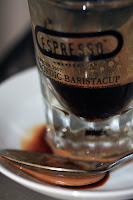All this week I’ve been playing around with crema, lots of different experiments and a lot of failed results. I did however find something interesting and definitely worth mentioning. So in regards to my previous post I am still trying to eliminate crema without physically removing it with a spoon.
 I’ve been trying to filter out the crema during the extraction using various filtration methods. All but one, have failed. I have found that filtering through filter paper will give a very unpleasant cardboard taste in the cup. The best filter turned out to be a single (9 gram) filter basket. Let me break it down a little bit. The espresso runs straight into the filter basket sifting through but the crema stays on top and filters out almost completely. The end result gives you the espresso liquid with slightly thin pale layer of crema (resemblant to that of aeropress). I guess the advantage of removing the crema this way is that it doesn’t mix in the cup during the initial stages of extraction.
I’ve been trying to filter out the crema during the extraction using various filtration methods. All but one, have failed. I have found that filtering through filter paper will give a very unpleasant cardboard taste in the cup. The best filter turned out to be a single (9 gram) filter basket. Let me break it down a little bit. The espresso runs straight into the filter basket sifting through but the crema stays on top and filters out almost completely. The end result gives you the espresso liquid with slightly thin pale layer of crema (resemblant to that of aeropress). I guess the advantage of removing the crema this way is that it doesn’t mix in the cup during the initial stages of extraction.After filtering out the crema I then compared both filtered and unfiltered espresso. This is what I found:
I am using a very sweet espresso blend rich and full of body with distinct dark chocolate notes.
Regular espresso (crema mixed in with a spoon thoroughly)
The smell carried out a subtle hint of berry and chocolate notes. The espresso was well balanced with smooth rich mouthfeel, slight bitterness and a distinct chocolate note.
Filtered Espresso
A very sharp oaky smell with hints of chocolate. Espresso was very sharp and clean with absolutely no body. Distinct taste of chocolate remained.

The conclusion that I have established indicated that the main characters of espresso (with crema) will carry out through filtration. In this instant the distinct chocolate note was very much present although the overall espresso lacked body. I personally prefer the espresso for what it is today a smooth, creamy, well balanced drink and all those aspects are tied in by ONE essential ingredient, crema. I also found that filtered espresso is good for picking out the main flavours and raw (bold) character out of the bean to more accurately describe its main taste.








